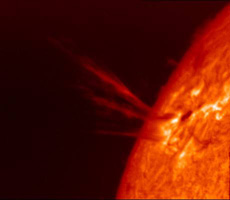Solar Flares
The Sun Shines on Compton's Front Porch

SOON Telescope image of a solar flare.
CREDIT: Holloman AFB/NOAA
Solar flares are explosions of energetic particles and electromagnetic
radiation in the outer atmosphere of the sun. Lessons learned from
solar explosions apply to much larger explosions that we see elsewhere
in the Universe. Closer to home, these particles from the sun can
cause communications and electrical problems on Earth.
Compton was launched just after the last solar maximum, a period of
increased solar activity. Fortunately the sun was still active, and
Compton got itself a tan with several large flares in June 1991. In
this regard, Compton was following in the footsteps of OSO Orbiting
Solar Observatory 7 (1971-'74) and the Gamma-Ray Spectrometer on the
Solar Maximum Mission (1980-'81, '84-'89), the only other space
missions to see gamma-ray emission lines in solar flares.
OSSE detected several nuclear emission lines from a solar flare on
June 4, 1991, including lines from iron, magnesium, neon, silicon,
carbon, oxygen and nitrogen. These give information about the
abundances of elements in the ambient coronal gas. EGRET detected a
high-energy afterglow from a solar flare on June 11, 1991. No
high-energy cutoff was detected, so presumably higher-energy photons
were also produced. The emission lasted for at least eight hours
after the impulsive phase of the flare. This afterglow may have been
due to either continuous acceleration or long-term plasma trapping.
COMPTEL detected neutrons
from a solar flare on June 15, 1991. This
resulted in the first particle image of any astrophysical source. The
sun may be the only astrophysical source that will ever be imaged in
neutrons, since neutrons decay with a half-life of only five minutes.
COMPTEL also detected a gamma-ray afterglow from the same flare. In
this case, the particles were likely not just accelerated during the
impulsive phase at the beginning of the flare, but were continuously
accelerated over an extended period of time.

CGRO Comptel's Neutron Image of the Sun
showing solar flare of June 15, 1991
Additional Links
 CGRO Web Site (http://cossc.gsfc.nasa.gov/) CGRO Web Site (http://cossc.gsfc.nasa.gov/)
|
